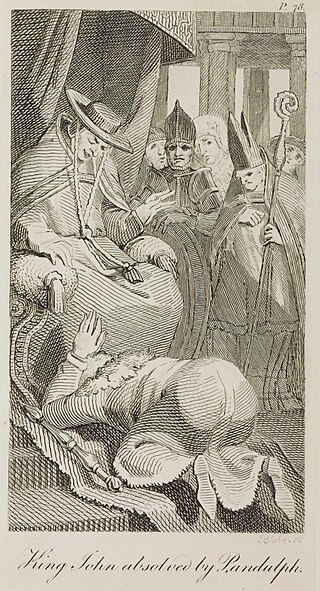Related Research Articles

Worcester Cathedral is an Anglican cathedral in Worcester, in Worcestershire, England, situated on a bank overlooking the River Severn. It is the seat of the Bishop of Worcester. Its official name is the Cathedral Church of Christ and the Blessed Mary the Virgin, of Worcester. The present cathedral church was built between 1084 and 1504, and represents every style of English architecture from Norman to Perpendicular Gothic. It is famous for its Norman crypt and unique chapter house, its unusual Transitional Gothic bays, its fine woodwork, and its "exquisite" central tower, which is of particularly fine proportions. The cathedral contains the tombs of King John, Prince Arthur and Prime Minister Stanley Baldwin.

Pandulf Verraccio, whose first name may also be spelled Pandolph or Pandulph, was a Roman ecclesiastical politician, papal legate to England and bishop of Norwich.
Philip de Harcourt was a medieval Lord Chancellor of England and Bishop of Bayeux. He was unsuccessfully elected as the Bishop of Salisbury.

Godfrey Giffard was Chancellor of the Exchequer of England, Lord Chancellor of England and Bishop of Worcester.

Peter des Roches was bishop of Winchester in the reigns of King John of England and his son Henry III. He was not an Englishman, but rather a native of the Touraine, in north-central France.
Nicholas of Ely was Lord Chancellor of England, Bishop of Worcester, Bishop of Winchester, and Lord High Treasurer in the 13th century.

The Diocese of Worcester forms part of the Church of England (Anglican) Province of Canterbury in England.
Jocelin of Wells was a medieval Bishop of Bath. He was the brother of Hugh de Wells, who became Bishop of Lincoln. Jocelin became a canon of Wells Cathedral before 1200, and was elected bishop in 1206. During King John of England's dispute with Pope Innocent III, Jocelin at first remained with the king, but after the excommunication of John in late 1209, Jocelin went into exile. He returned to England in 1213, and was mentioned in Magna Carta in 1215.

The Bishop of Worcester is the head of the Church of England Diocese of Worcester in the Province of Canterbury, England.
Thomas Cobham was an English churchman, who was Archbishop-elect of Canterbury in 1313 and later Bishop of Worcester from 1317 to 1327.
Roger Niger was a thirteenth-century cleric who became Bishop of London. He is also known as Saint Roger of Beeleigh.
William de Blois was a medieval Bishop of Lincoln. He first served in the household of Hugh du Puiset, the Bishop of Durham, then later served the household of Hugh of Avalon, Bishop of Lincoln. After Hugh's death and a two-year vacancy in the see, or bishopric, Blois was elected to succeed Hugh in 1203. Little is known about his episcopate, although 86 of his documents survive from that time period. He died in 1206 and was buried in his cathedral.
William Middleton was a medieval Bishop of Norwich.
William de la Corner was a medieval Bishop of Salisbury, who fought a long but unsuccessful battle to become Archbishop of Dublin.
William of Northall was a mediaeval Bishop of Worcester.
Robert FitzRalph was a medieval Bishop of Worcester.
John of Coutances was a medieval Bishop of Worcester.
Sylvester was a medieval Bishop of Worcester.

During the Middle Ages there was a small Jewish community in Worcester, a city and county town of Worcestershire in the West Midlands of England that mainly provided money lending services to the non-Jewish citizens. Worcester also hosted a national gathering of England's leading Jews in 1241, to allow the Crown to assess their worth for taxation. The Worcester Bishopric was hostile to the Jewish community in Worcester, commissioning tracts against Jewry, and pushing for segregation of Jews and Christians. During the Second Barons' War, Jews suffered violence and many died in 1255, at the hands of Simon de Montfort's supporters.
Charles Booth, D.C.L. was a sixteenth-century clergyman who served as the Bishop of Hereford from 1516 to 1535.
References
- British History Online Archdeacons of Buckingham accessed on 3 November 2007
- British History Online Bishops of Worcester accessed on 3 November 2007
- Fryde, E. B.; Greenway, D. E.; Porter, S.; Roy, I. (1996). Handbook of British Chronology (Third revised ed.). Cambridge: Cambridge University Press. ISBN 0-521-56350-X.
- Vincent, Nicholas (1994). "Two Papal Letters on the Wearing of the Jewish Badge, 1221 and 1229". Jewish Historical Studies. 34: 209–224. JSTOR 29779960.